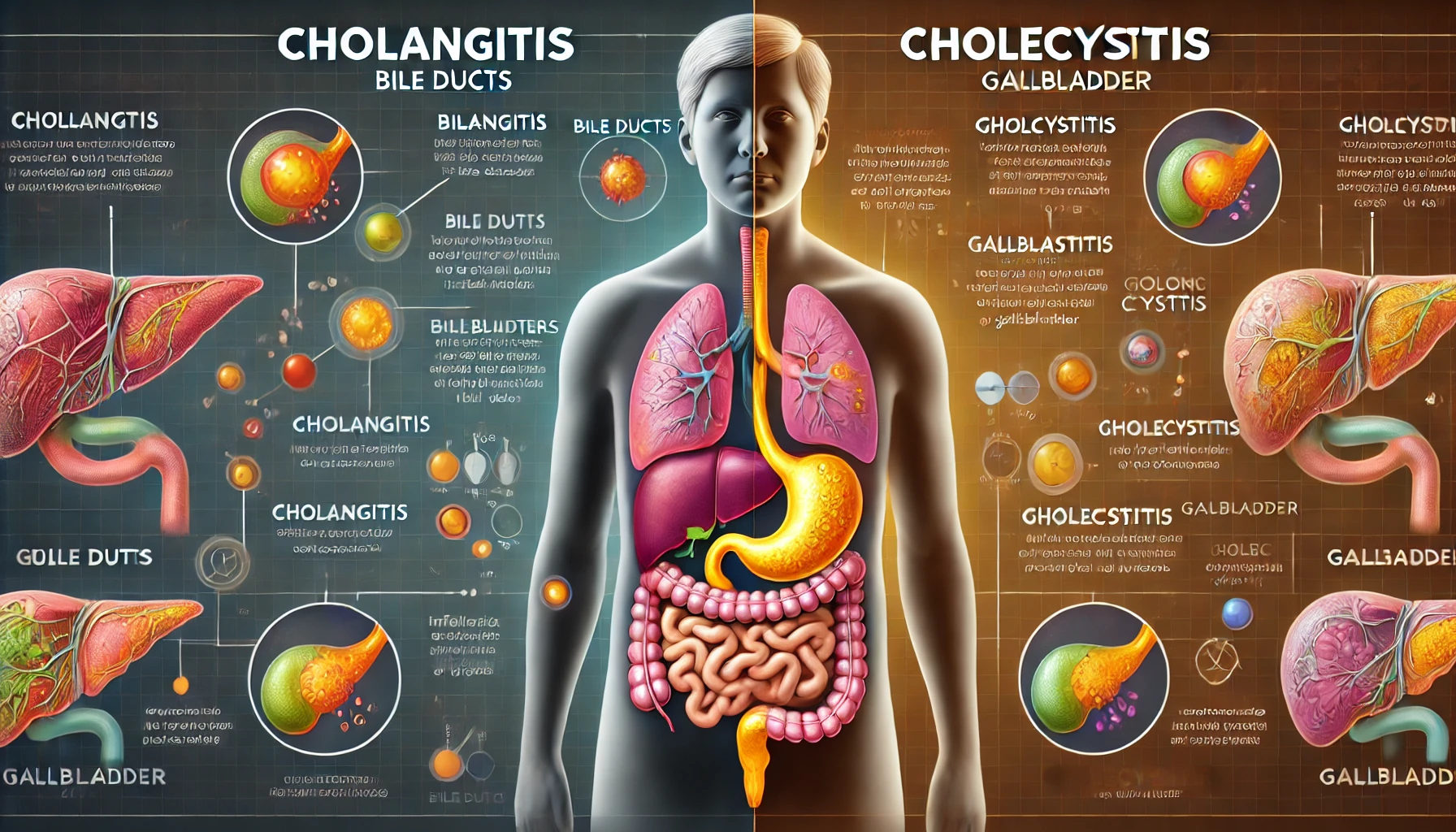When it comes to conditions affecting the bile ducts and gallbladder, two common terms you may encounter are cholangitis and cholecystitis. While they might sound similar, these are distinct medical conditions that require different treatment approaches. Understanding the differences between cholangitis vs cholecystitis is essential for proper diagnosis and treatment.
In this blog, we will break down the symptoms, causes, and treatments for both conditions and explain why hydration plays an important role in managing them. Let’s explore these two health issues in detail.
What is Cholangitis?
Cholangitis refers to the inflammation or infection of the bile ducts, which carry bile from the liver and gallbladder to the small intestine. Bile is essential for the digestion of fats. When a blockage or infection occurs in the bile ducts, inflammation results, leading to cholangitis.
Cholangitis can be acute or chronic. The most common form of cholangitis is acute cholangitis, also known as ascending cholangitis. It typically occurs when bacteria enter the bile ducts due to a blockage caused by gallstones, tumors, or strictures.
Symptoms of Cholangitis
Symptoms of cholangitis can vary based on the severity of the condition. Common signs include:
- Fever with chills
- Jaundice (yellowing of the skin and eyes)
- Pain in the upper right abdomen
- Nausea and vomiting
- Dark urine or pale stools
- Confusion (in severe cases)
These symptoms often form a classic trio known as Charcot’s triad (fever, jaundice, and abdominal pain), which is a hallmark of cholangitis.
Causes of Cholangitis
Cholangitis usually results from bacterial infections. These infections can enter the bile ducts due to:
- Gallstones blocking the bile ducts
- Tumors or strictures (narrowing of the bile ducts)
- Biliary stents that become infected
- Pancreatic issues or surgery complications
Blockages in the bile ducts prevent bile from flowing properly, creating an environment where bacteria can thrive, leading to infection.
What is Cholecystitis?
Cholecystitis refers to the inflammation of the gallbladder. The gallbladder is a small organ that stores bile, releasing it into the small intestine to aid digestion. Cholecystitis occurs when bile becomes trapped in the gallbladder due to a blockage, leading to inflammation.
The most common form of cholecystitis is acute cholecystitis, which is often caused by gallstones blocking the cystic duct, a small tube that connects the gallbladder to the bile ducts.
Symptoms of Cholecystitis
Symptoms of cholecystitis can resemble those of cholangitis, but there are key differences. Common signs of cholecystitis include:
- Severe pain in the upper right or center of the abdomen
- Pain that radiates to the right shoulder or back
- Nausea and vomiting
- Fever
- Abdominal tenderness
The pain from cholecystitis can last for several hours and typically worsens after eating, especially after consuming fatty foods.
Causes of Cholecystitis
Cholecystitis often occurs when a gallstone blocks the cystic duct, causing bile to build up in the gallbladder, which leads to inflammation. Other causes include:
- Tumors or growths that block bile flow
- Biliary sludge (thickened bile)
- Bacterial infections
- Trauma to the gallbladder
- Tumors or abnormalities that affect gallbladder function
Cholangitis vs Cholecystitis: Key Differences
While cholangitis vs cholecystitis share some similarities, they are distinct conditions with different causes and affected areas of the biliary system. Below, we outline the key differences:
- Location of Inflammation:
- Cholangitis affects the bile ducts.
- Cholecystitis affects the gallbladder.
- Cause of Inflammation:
- Cholangitis is primarily caused by infections due to blockages in the bile ducts.
- Cholecystitis is usually caused by gallstones blocking the cystic duct, leading to trapped bile.
- Symptoms:
- Cholangitis often presents with Charcot’s triad: fever, jaundice, and right upper quadrant abdominal pain.
- Cholecystitis typically causes severe abdominal pain that radiates to the shoulder, with nausea and vomiting.
- Treatment:
- Cholangitis usually requires antibiotics and, in some cases, a procedure to drain the bile ducts.
- Cholecystitis often requires surgical removal of the gallbladder (cholecystectomy) or treatment with antibiotics if the condition is caused by infection.
- Severity:
- Cholangitis can be a medical emergency if left untreated, as it can lead to life-threatening complications like sepsis.
- Cholecystitis is generally less severe but can cause complications if not addressed, such as gallbladder rupture.
Understanding these key differences between cholangitis vs cholecystitis is essential for accurate diagnosis and timely treatment.
For more information on these two conditions, visit cholangitis vs cholecystitis.
The Role of Hydration in Managing Cholangitis and Cholecystitis
Proper hydration plays an important role in managing and preventing complications related to both cholangitis and cholecystitis. Staying hydrated helps maintain healthy bile flow and prevents bile from becoming too concentrated, which can reduce the risk of gallstones forming. Dehydration can contribute to bile stasis, leading to an increased risk of infection or blockage in the bile ducts.
For individuals recovering from these conditions, drinking enough water can also help flush toxins from the body, reduce inflammation, and promote healing. Hydration supports the liver’s ability to produce bile and keeps the digestive system functioning optimally.
In addition to hydration, patients should focus on eating a low-fat, balanced diet to reduce stress on the liver and gallbladder. Avoiding alcohol is crucial, as it can exacerbate inflammation and slow recovery. If you need help with quitting alcohol, visit How To Stop Drinking Alcohol Permanently for resources and support.
Treatment Options for Cholangitis
Treating cholangitis depends on the severity of the condition and the underlying cause. Treatment may include:
- Antibiotics: Antibiotics are prescribed to treat the bacterial infection that causes cholangitis. Early intervention with antibiotics can prevent complications.
- ERCP (Endoscopic Retrograde Cholangiopancreatography): This procedure is used to remove blockages, such as gallstones or tumors, in the bile ducts.
- Percutaneous Drainage: If the bile ducts cannot be cleared through ERCP, a drainage procedure may be required to relieve the obstruction.
- Surgery: In severe cases, surgery may be needed to remove blockages or treat bile duct issues.
Early diagnosis and treatment are critical for preventing severe complications, such as sepsis or liver damage.
Treatment Options for Cholecystitis
Treatment for cholecystitis often involves:
- Antibiotics: Antibiotics are given if the inflammation is caused by infection.
- Cholecystectomy (Gallbladder Removal): Surgery to remove the gallbladder is the most common treatment for cholecystitis, especially if gallstones are the cause. This procedure can be performed laparoscopically (minimally invasive) or through traditional open surgery.
- Fasting and IV Fluids: Patients may be advised to fast and receive IV fluids to allow the gallbladder to rest.
- Pain Management: Medications to manage pain and discomfort are often prescribed.
Gallbladder removal is generally a safe procedure, and patients can live a healthy life without their gallbladder.
Preventing Cholangitis and Cholecystitis
While some risk factors for cholangitis and cholecystitis, such as genetics, cannot be controlled, certain lifestyle changes can reduce your risk. Here are some prevention tips:
- Stay Hydrated: Drink plenty of water to keep bile flowing smoothly and prevent the formation of gallstones.
- Eat a Balanced Diet: Focus on a low-fat diet rich in fiber, fruits, vegetables, and whole grains to promote liver and gallbladder health.
- Exercise Regularly: Physical activity helps maintain a healthy weight and reduces the risk of gallstones.
- Avoid Alcohol: Excessive alcohol consumption can damage the liver and increase the risk of bile duct and gallbladder issues. For those seeking to quit alcohol, visit How To Stop Drinking Alcohol Permanently.
Conclusion
Understanding the differences between cholangitis vs cholecystitis is essential for recognizing symptoms, seeking timely treatment, and preventing complications. While both conditions involve inflammation in the biliary system, they affect different areas and require different approaches to treatment.
Staying hydrated, maintaining a healthy diet, and addressing any underlying health conditions are key to managing and preventing both cholangitis and cholecystitis. If you’re experiencing symptoms of either condition, seek medical attention promptly to ensure proper care and recovery.


